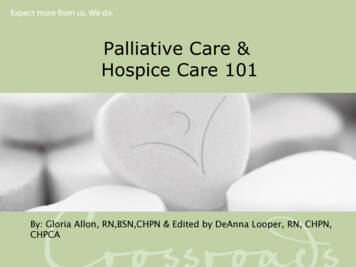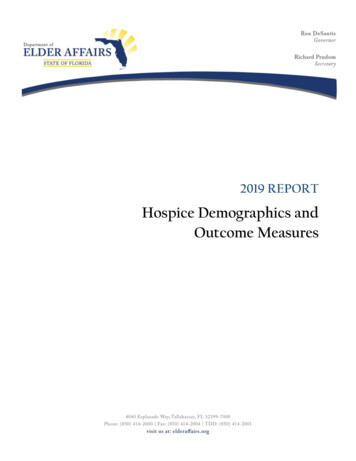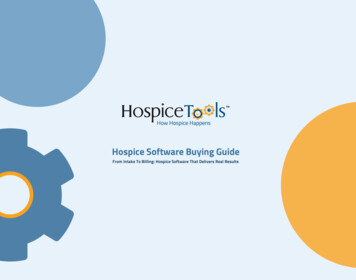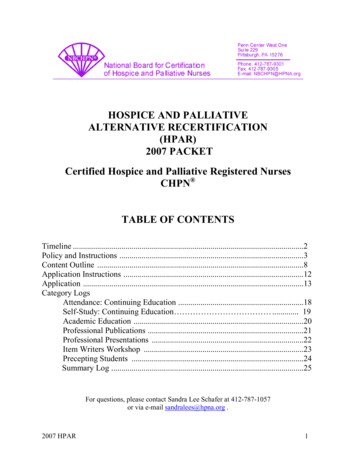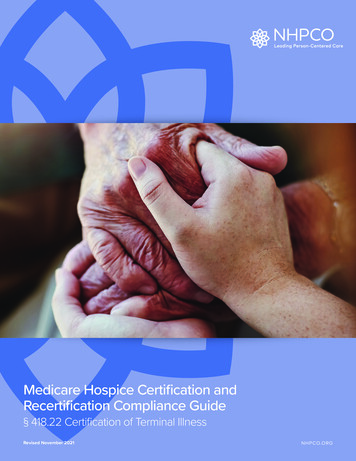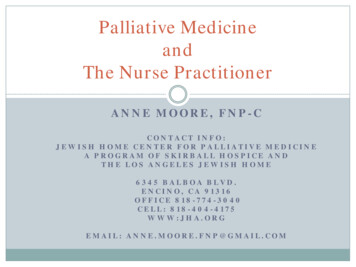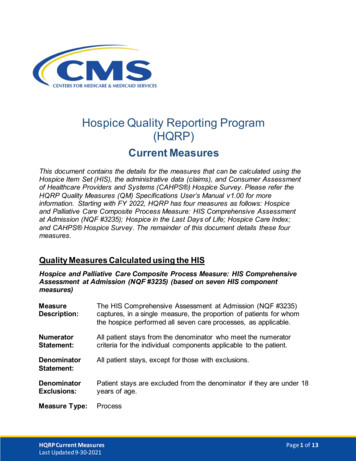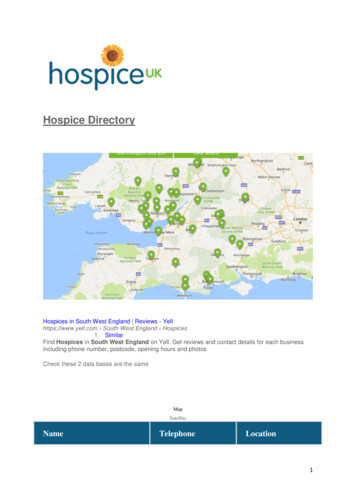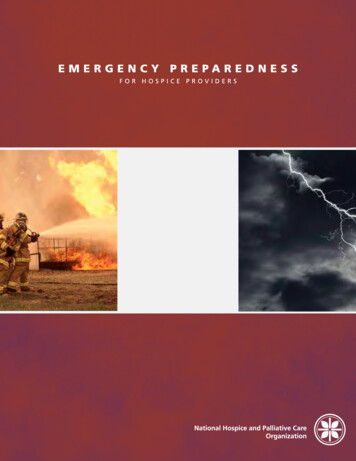
Transcription
National Hospice and Palliative Care Organization, 20171
AcknowledgementsNHPCO gratefully acknowledges the following individuals for their contributions to this valuableresource:Janine Cacciatore, BSN, MBA, CHPCAAdministratorGold Coast Home Health & HospiceFort Lauderdale, FL 33316Dianne Hansen, MT (ASCP), MHA, BCHH-C, COS-CDirector of Clinical OperationsPartners In Home Care, Inc.Missoula, MT 59808Ted KennedyOperations Division, Office of Emergency ManagementOffice of the Assistant Secretary for Preparedness and ResponseUS Department of Health & Human ServicesWashington, DC 20024Annette Kiser, MSN, RN, NE-BCDirector of Quality & ComplianceThe Carolinas Center for Hospice & End of Life CareRaleigh, NC 27615Staff SupportJennifer Kennedy, MA, BSN, RN, CHCSenior Director, Regulatory and QualityNational Hospice and Palliative Care OrganizationJudi Lund Person, MPH, CHCVice President, Regulatory and ComplianceNational Hospice and Palliative Care Organization National Hospice and Palliative Care Organization, 20172
Table of ContentsSection I - IntroductionSection II - Getting to know the disaster response systemSection III - Action steps for complianceProvision (a) – Emergency planProvision (b) – Policies and proceduresProvision (c) – Communication planProvision (d) – Training and testingProvision (e) – Integrated health systemsReferencesAppendices Appendix A - Assessing the hazardAppendix B - Resources for patients and familiesAppendix C - Provider resourcesAppendix D – Hospice Emergency Preparedness CoP Compliance Checklist National Hospice and Palliative Care Organization, 20173
Section I - IntroductionHospice care is an interdisciplinary palliative care approach that focuses on symptommanagement rather than curative treatment for a terminally ill patient. Hospice palliative care improvesthe quality of life for patients and their families who face the problems associated with terminal illnessby preventing and relieving suffering through early identification, assessment, and treatment of painand other issues. Hospices use an interdisciplinary team to provide medical, social, physical, emotional,and spiritual services through the use of a broad spectrum of caregivers while allowing the patient toremain in their home environment and maintain his or her dignity (The Centers for Medicare andMedicaid Services, 2016).Hospices are unique health care providers because they serve patients and their families in awide variety of settings. Hospice patients receive care in whatever setting they call home which could betheir private residence, a nursing home, an assisted living facility, or even a recreational vehicle, as longas such locations are determined to be the patient’s place of residence. Hospice patients may also beserved in inpatient facilities operated by the hospice. It is important that hospice providers understandhow to interact with their community emergency preparedness resources and how it connects to thefederal disaster response system before disaster strikes (CMS, 2016).Prior to the posting of Emergency Preparedness Requirements for Medicare and MedicaidParticipating Providers and Suppliers (CMS-3178-F), the federal hospice regulations required provisionsrequiring hospice inpatient facilities to have a written disaster preparedness plan that is periodicallyrehearsed with hospice employees, with procedures to be followed in the event of an internal orexternal disaster, and procedures for the care of casualties (patients and staff) arising from suchdisasters. This requirement, which was limited in scope, was found at § 418.110(c)(1)(ii) under‘‘Standard: Physical environment.’’ The new Condition of Participation ‘§418.113, Emergencypreparedness’ groups include requirements that apply to all hospice providers at §418.113(b)(1) through§ 418.113(b)(5) followed by requirements at §418.113(b)(6) that apply only to hospice inpatient carefacilities (CMS, 2016). National Hospice and Palliative Care Organization, 20174
Why a new regulation?During a disaster, a hospice must be ready to continue cares for patients who do not requirehospitalization or cannot be admitted into overwhelmed health care facilities. Depleted supplies,personnel shortages, and other challenges during times ofcrisis may strain an agency’s ability to address their patients’needs. Thorough preparedness planning is essential forensuring that the needs of patients and caregivers are metin the most effective and professional manner possible.The Centers for Medicare & Medicaid Services(CMS), issued Emergency Preparedness Requirements forMedicare and Medicaid Participating Providers and Suppliers(CMS-3178-F) with an implementation date of November 15, 2017. This final rule establishes nationalemergency preparedness requirements for Medicare and Medicaid participating providers and suppliersto ensure that they adequately plan for both natural and man-made disasters, and coordinate withfederal, state, tribal, regional, and local emergency preparedness systems. It also ensures that providersare adequately prepared to meet the needs of patients and families during disasters and emergency*situations. Disasters can disrupt the environment of health care and change the demand for health careservices. Regulatory requirements make it necessary that health care providers and suppliers ensurethat emergency management is integrated into their daily operation and culture (CMS, 2016).*In this regulatory guidance, CMS defines "emergency" or "disaster" as an event affecting theoverall target population or the community at large that precipitates the declaration of a stateof emergency at a local, state, regional, or national level by an authorized public official such asa governor, the Secretary of the Department of Health and Human Services (HHS), or thePresident of the United States (CMS, 2016).After CMS conducted an extensive review of emergency preparedness guidance from multipleagencies of the federal government, they concluded that current emergency preparedness regulatoryrequirements were not comprehensive enough to address the complexities of actual emergencies.Specifically, the requirements did not address the need for:(1) communication to coordinate with other systems of care within local jurisdictions (for example.cities, counties) or states;(2) contingency planning; and National Hospice and Palliative Care Organization, 20175
(3) training of personnelAdditionally, through analysis of written reports, articles, and studies, as well as their continuingdiscussion with representatives from the federal, state, and local levels and with various stakeholders,CMS believed that in the event of a disaster, health care providers across the nation would not have thenecessary emergency planning and preparation in place to adequately protect the health and safety oftheir patients. Underlying this problem was the pressing need for a more consistent regulatory approachthat would ensure that providers and suppliers nationwide are required to plan for and respond toemergencies and disasters that directly impact patients, families, and their communities (CMS, 2016).CMS determined that the regulatory potpourri of federal, state, local laws and guidelines, andaccrediting organization emergency preparedness standards, did not meet what was required for healthcare providers to be adequately prepared for a disaster. Thus, the new emergency preparednessrequirements establish a comprehensive, consistent, flexible, and dynamic regulatory approach toemergency preparedness and response that incorporates the lessons learned from the past, combinedwith the proven best practices of the present (CMS, 2016). National Hospice and Palliative Care Organization, 20176
Section II - Getting to Know the Disaster Response System(Federal, State, Local)There are different types of disaster threats and they can be categorized as acts of nature orhumans. Natural disasters include earthquakes, tornadoes, floods, fires, hurricanes, or an infectiousdisease outbreak. Manmade disasters can include industrial accidents, shootings, terrorism,and incidents of mass violence. These types of traumatic events threaten humanity and may cause lossof life and property. They may also prompt evacuations from certain areas and overwhelm behavioralhealth resources in the affected communities. The federal government has structure and resources forresponse and management of all types of disaster threats that reach into state and local communities(Disaster Assistance, 2016). It is important to understand the disaster response system and how yourlocal and state governments interface with the federal disaster response system.Disasters always occur locally, thus the people in the area where the event occurs and their localgovernments and voluntary agencies are the first to have to handle the outcomes. The localgovernment maintains control of all resources used in the response and recovery efforts, regardless ofthe source of those resources. Local governments plan and prepare for this role with the support of the State and Federalgovernments. A local jurisdiction may seek assistance fromwww.DisasterAssistance.govtheir State government in a disaster situation; but, keep inprovides information aboutmind that the State government may have many localtypes of disasters andjurisdictions requesting aid at the same time. Mostresources about specificemergencies are managed at the local level, without assistancedisastersfrom the State or the Federal government and only a smallnumber result in a request for Federal assistance. State governments serve as liaisons for the local jurisdictions ifFederal disaster assistance is needed as local governments cannot directly access Federal programs(Federal Emergency Management Agency, 2014).The Federal government becomes the source for resources when a disaster is so severe that thelocal governments and the State governments together cannot provide the needed resources. TheFederal Emergency Management Agency (FEMA) is the Federal agency that coordinates the activationand implementation of the Federal Response Plan (FRP), so the States work with FEMA to access Federalprograms and support. The FRP defines how the resources of Federal agencies and the American RedCross will coordinate to provide immediate response assistance to a state (FEMA, 2014).Sequence of a Disaster ResponseA. Local disaster response includes:1. Acting as the primary “first provider” of emergency response services.2. Activating the Emergency Operations Center (EOC) and Emergency Management Plan.3. Coordinating the response with public and private organizations and agencies.4. Updating the State Emergency Management Agency regularly by providing reports.5. Activating response agreements with State and Federal departments or agencies. National Hospice and Palliative Care Organization, 20177
6. Proclaiming a local state of emergency to authorize:a. Using local resources;b. Expending local funds; andc. Waiving the usual bidding process for goods and services.7. Requesting the State Emergency Management Agency to provide State and/or Federalassistance (FEMA, 2014).B. State disaster response includes:1. Monitoring the situation.2. Reviewing and evaluating local updates, response efforts, and requests for assistance.3. Activating the State EOC to coordinate available State assistance.4. Determining if Federal assistance is needed.5. Declaring a state of emergency by the Governor that:a. Activates the State Disaster Preparedness Plan;b. Activates the use of State assistance or resources;Note: A Governor can declare a statewide state of emergency or designate specific counties orlocal jurisdictions.6. Initiates the process for requesting Federal assistance (FEMA, 2014).C. Federal disaster response includes:Federal disaster response is managed through the Incident Command System (ICS). The ICS isdesigned to enable effective and efficient local and national incident management by integrating acombination of facilities, equipment, personnel, procedures, and communications operating withina common organizational structure. The ICS includes procedures to select and form temporarymanagement hierarchies to control funds, personnel, facilities, equipment, and communications.The role of the ICS is to meet the needs of a jurisdiction to assist them coping with disasters of anytype or complexity (i.e. it expands or contracts as needed) (FEMA, 2016). During an emergency ordisaster, the Federal disaster response includes:1. Communicating with State and local governments to identify:a. Destruction to individuals, farms, and businesses, public agencies, special districts, andprivate nonprofit organizations;b. Potential relief activities that can occur during repairs and before another disaster.2. Approving or denying requests for Federal assistance.3. Activating the measures outlined in the Federal Response Plan.4. Establishing an Emergency Support Team (EST) to monitor disaster response and operationsfrom Washington, D. C.5. Identifying necessary Emergency Support Functions (ESF) to respond to the disaster (FEMA,2014). National Hospice and Palliative Care Organization, 20178
All about Federal 1135 WaiversAn 1135 Waiver is an allowance under section 1135 of the Social Security Act (SSA) and relaxesregulatory requirements in a disaster area or during an emergency situation. An 1135 Waiver can berequested by a State or individual provider when: The U.S. President declares a major disaster or an emergency under the Stafford Act or anemergency under the National Emergencies Act, andThe U.S. Department of Health and Human Services (HHS) Secretary declares a public healthemergency. The Secretary is authorized to take certain actions in addition to his or her regularauthorities under section 1135 of the Social Security Act (Public Health Emergency, 2013).The Secretary may waive or moderate certain Medicare, Medicaid, Children’s Health InsuranceProgram (CHIP) and Health Insurance Portability and Accountability Act (HIPAA) requirements asnecessary to ensure sufficient health care items and services are available to meet the needs ofindividuals enrolled in Social Security Act (SSA) programs to the maximum extent feasible in anemergency area during an emergency period. Providers of these services, in good faith, who areunable to comply with certain statutory requirements are reimbursed and exempted from sanctionsfor noncompliance other than fraud or abuse (PHE, 2013). The Waiver usually ends when theemergency response ends, or 60 days from the date the waiver or modification is first published unlessthe Secretary of HHS extends the waiver by notice for additional periods of up to 60 days, up to theend of the emergency period (CMS, 2009).The 1135 Waiver allows only regulations that govern provision of care to be waived or modified,not conditions of payment. For example, hospice requirements for a face-to face encounter cannot bewaived by an 1135 Waiver because it is considered to be condition of payment. A face-to-face encountermust occur no more than 30 days prior to the start of the third benefit period and 30 days prior to anysubsequent benefit periods thereafter. Therefore, the hospice face-to-face requirement cannot bewaived under Section 1135 of the Act. If the emergency causes a provider to expect to be unable tomeet these timeframes, that provider should contact their CMS Regional Office to allow for tracking andcompletion of this encounter as soon as conditions allow (CMS, 2013a).Conditions of care provision that may be waived or modified under the 1135 Waiver include: Certain conditions of participation certification requirements, program participation or similarrequirements for individual health care providers or types of health care providers;Requirements that physicians and other health care professionals hold licenses in the state inwhich they provide services if they have a license from another state (and are not affirmativelybarred from practice in that state or any state in the emergency area) for purposes of Medicare,Medicaid, and CHIP reimbursement only;Deadlines and time tables for performance of required activities to allow timing of suchdeadlines to be modified;Sanctions and penalties arising from noncompliance with HIPAA privacy regulations relating to:o Obtaining a patient’s agreement to speak with family members or friendso Honoring a patient’s request to opt out of the facility directory National Hospice and Palliative Care Organization, 20179
ooDistributing a notice of privacy practicesHonoring the patient’s right to request privacy restrictions or confidentialcommunications (PHE, 2013)The waiver of HIPAA requirements is effective only if actions under the waiver do not discriminate onthe basis of a patient’s source of payment or ability to pay (PHE, 2013).The 1135 Waiver allowance does not expand beyond the designated "emergency area," whichis defined as the area in which there has been both a Stafford Act or National Emergencies Actdeclaration and a public health emergency declaration. However, Medicare does allow for certainlimited flexibilities outside the scope of the 1135 waiver, and some of these flexibilities may beextended to areas beyond the confirmed emergency area (CMS, 2013b).More Information about the 1135 Waiver Additional Emergency and Disaster-Related Policies and Procedures (CMS)Requesting an 1135 Waiver (CMS)Authority To Waive Requirements During National Emergencies (SSA) National Hospice and Palliative Care Organization, 201710
Section III - Action Steps for Regulatory ComplianceEvery provider type under Medicare must comply with the new regulatory requirements underthis final rule, so hospice providers should not feel that they are alone in preparing for compliance. Infact, a hospice may not even need to reinvent the wheel depending on the local community’s currentresources. The first Federal disaster relief was in a Congressional Act of 1803 which provided assistanceto a New Hampshire town following an extensive fire (FEMA, n.d.). Comprehensive, timely planningprovides the foundation for effective emergency management. The response to an emergency canimpact an entire community and can involve numerous medical and public health entities, includinghealth care provider systems, public health departments, emergency medical services, medicallaboratories, individual health practitioners, and medical support services (CMS, 2015).Federal, State, County (Parish) and local governments as well as a wide array of businesses and avariety of professional organizations have been developing disaster plans for a very long time. There is auniverse of well-developed plans and tools available. If the hospice provider approaches compliancewith a “create from scratch” attitude, a lot of time and energy can be wasted, and a provider may belikely to miss some of the insights and best practices that have been researched, developed, and provenover the last few hundred years. It is important to keep in mind when planning for disaster responsethat it does not matter what type of disaster strikes, the response the provider takes is generally goingto be the same. Also, bear in mind that there is forewarning related to many natural disasters, which isthe first step for any provider to prepare and plan to ensure optimal patient care.During a disaster or emergency, a coordinated response is essential. The CMS states thatcomprehensive emergency management includes the following phases: Hazard Identification: Health care providers should make every effort to include any potentialhazards that could affect the facility directly and indirectly for the particular area where it islocated. Indirect hazards could affect the community, but not the provider, and as a resultinterrupt necessary utilities, supplies or staffing.Hazard Mitigation: Hazard mitigation includes action taken to eliminate or reduce theprobability of the event, or reduce its severity or consequences, either prior to or following adisaster or emergency.o The emergency plan should include mitigation processes for both residents and staff.o Mitigation details should address care for the hospice facility, and how the facility willeducate staff in protecting themselves in the likelihood of an emergency.o Comprehensive hazard mitigation efforts, including staff education, will aid in reducingstaffs' vulnerability to potential hazards.o These activities precede any imminent or post-impact timeframe and are consideredpart of the response.Preparedness: Preparedness includes developing a plan to address how the provider will meetthe needs of patients and residents if essential services break down because of a disaster. Acompleted preparedness plan will be the product of a review of the basic facility information, National Hospice and Palliative Care Organization, 201711
hazard analysis and an examination of the provider's ability to continue providing care andservices during an emergency. It also includes training staff on their role in the emergency plan,testing the plan, and revising the plan as needed. Response: Activities immediately before (for an impending threat), during and after a hazardimpact must address the immediate and short-term effects of the emergency.Recovery: Activities and programs implemented during and after response are designed toreturn the hospice facility to its usual state or a "new normal."The Regulations - § 418.113 Condition of Participation: Emergency preparedness.The regulatory requirements in the federal Conditions of Participation (CoP) at §418.110 related toemergency preparedness have been amended by removing the blue italicized paragraph below andmoving all requirements to §418.113 Condition of participation: Emergency preparedness.§418.110 Condition of participation: Hospices that provide inpatient care directly.(c) Standard: Physical environment. The hospice must maintain a safe physical environment freeof hazards for patients, staff, and visitors.(1)Safety management.The hospice must address real or potential threats to the health and safety of thepatients, others, and property.(ii) The hospice must have a written disaster preparedness plan in effect formanaging the consequences of power failures, natural disasters, and otheremergencies that would affect the hospice’s ability to provide care. The planmust be periodically reviewed and rehearsed with staff (including nonemployee staff) with special emphasis placed on carrying out the proceduresnecessary to protect patients and others.This new CoP addresses all regulatory requirements for hospice providers includingrequirements for providers who own their own inpatient hospice facility. The hospice must establishand maintain an emergency preparedness program that meets the outlined requirements and they mustcomply with all applicable Federal and State emergency preparedness requirements. The emergencypreparedness program must include, but not be limited to, the following provisions illustrated in thefigure below:(a) Risk assessment andplanning(b) Policies andproceduresEmergencypreparednessprogram(c) Communication plan(d) Training and testing National Hospice and Palliative Care Organization, 2017There is an additionalprovision (e) that providesguidance and outlinesrequirements for hospiceproviders that are part of anintegrated healthcaresystem.12
NHPCO has added the following emergency preparedness standard to the NHPCO Standards of Practicefor Hospice Programs under CES 11: Clinical Excellence and Safety (CES).Standard:CES 11 The hospice develops, implements, and evaluates a plan for emergency preparedness, whichincludes the development of policies and procedures, a communication plan, and training and testingprogram and that is evaluated and rehearsed annually.CES 11.1 The hospice performs facility-based and community-based risk assessments, utilizingan all-hazards approach to determine areas of vulnerability for disaster response.CES 11.2 The hospice has a written emergency preparedness plan that provides for thecontinuation of services in the event of an emergency or disaster. The emergency preparednessplan minimally addresses:1. Policies and procedures that address staffing, provision of patient services, evacuation,sheltering in place, safeguard of supplies, maintenance of clinical records, andcollaboration with other community providers;2. Strategies for addressing emergency events identified by the risk assessment;3. A plan for the management of consequences from power failures, natural disasters, andother emergencies that would affect the hospice's ability to provide care;4. The types of services the hospice has the ability to provide in an emergency;5. Continuity of operations, including delegations of authority and succession plans;6. Processes for cooperation and collaboration with local, tribal, regional, state, or federalemergency preparedness officials' efforts to maintain an integrated response during adisaster or emergency situation; and7. Documentation of collaboration and participation with local, tribal, regional, state, orfederal emergency preparedness officials', when applicable, in planning efforts.CES 11.3 The hospice develops and maintains a communication plan that is updated annually.The communication plan minimally addresses:1. Contact information (primary and alternate) for hospice staff, contractors, and federal,state, tribal, regional, and local emergency preparedness staff;2. A process for sharing hospice patient information and clinical documentation, asnecessary, with other health care providers to maintain the continuity of care;3. A process to furnish patient information and disclose information about the generalcondition and location of patients under a hospice’s care as permitted under the HealthInsurance Portability and Accountability Act , in the event of an evacuation; and4. A process to provide information about a hospice's inpatient unit occupancy, needs, andits ability to provide assistance to emergency preparedness officials.CES 11.4 Training and testing on the hospice’s emergency preparedness plan, communicationplan, and related policies and procedures is provided to all new and existing hospice employees, National Hospice and Palliative Care Organization, 201713
and individuals providing services under a contractual arrangement with the hospice at leastannually. The training and testing program minimally addresses:1. Staff knowledge of emergency procedures;2. Documentation of all emergency preparedness training;3. Exercises to test the emergency plan that include participation in a full-scale exercisethat is community- or facility-based, as well as facilitation of an additional activity thatmay include a second full-scale exercise or a tabletop exercise; and4. Documentation of testing and lessons learned.CES 11.5 The hospice is integrated into the broader community network and is prepared torespond to broader community needs as a result of a natural or civil disaster (e.g., relocationoptions for patients, requests for bereavement services, increased referrals).Practice Examples: The hospice creates and regularly updates a telephone tree, using mobile telephones asnecessary, to facilitate communication with the staff during an emergency. The hospice reviews the emergency preparedness plan with all new employees,volunteers, and contracted staff during initial orientation and annually thereafter. The hospice considers preparation for multiple disasters (e.g., multiple storms orextended utility loss). The hospice has an internal plan related to its involvement in the greater communityrelated to its role in response to a natural or civil disaster. The hospice completes a debriefing after any activation of the emergency preparednessplan to assess the need for revision to the plan for increased effectiveness in futureevents. The hospice has a crisis communication plan for communicating internally with staff andvolunteers and externally with the media. The hospice participates annually in a state-wide or country-wide drill that includestriaging patient needs in an emergency.The information in this section provides discussion of the regulatory requirements, issues forconsideration, and resources for compliance for each provision in the CoP.Provision (a) Emergency planThe hospice must develop and maintain an emergency preparedness plan that must be reviewed andupdated at least annually. The plan must do the following:1. Be based on and include a documented, facility-based and community-based riskassessment, utilizing an all-hazards approach. National Hospice and Palliative Care Organization, 201714
2. Include strategies for addressing emergency events identified by the risk assessment,including the management of the consequences of power failures, natural disasters, andother emergencies that would affect the hospice’s ability to provide care.3. Address patient population, including, but not limited to, the type of services the hospicehas the ability to provide in an emergency; and continuity of operations, includingdelegations of authority and succession plans.4. Include a process to locate patients to assess their safety status.5. Include a process for cooperation and collaboration with local, tribal, regional, State, orFederal emergency preparedness officials' efforts to maintain an integrated response duringa disaster or emergency situation, including documentation of the hospice's efforts tocontact such officials and, when applicable, of its participation in collaborative andcooperative planning efforts (CMS, 2016).Planning is a continuous process for optimal emergencypreparedness. The regulations require a hospice to develop anemergency plan for their response to the disaster, includingpersonnel who will be involved and other resources. Once a plan hasbeen developed, staff members w
Missoula, MT 59808 . Ted Kennedy . The Carolinas Center for Hospice & End of Life Care . Raleigh, NC 27615 . Staff Support . Jennifer Kennedy, MA, BSN, RN, CHC . Senior Director, Regulatory and Quality . National Hospice and Palliative Care Organization . government maintains control of all resources used in the response and recovery .
